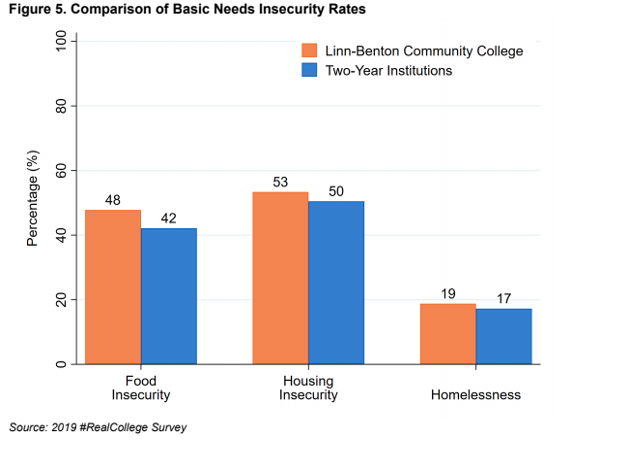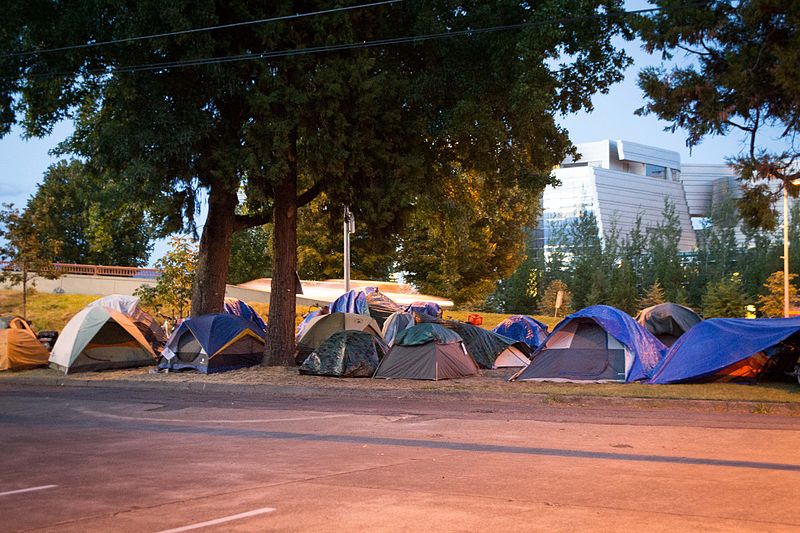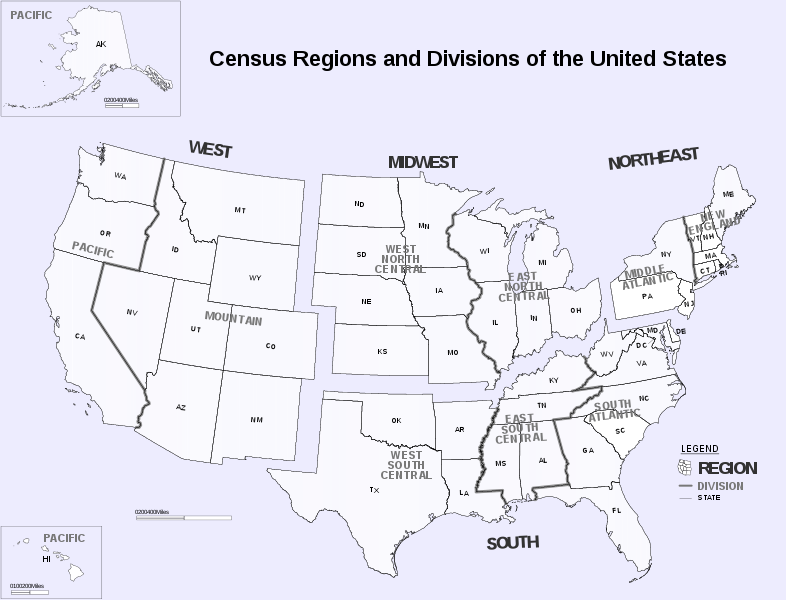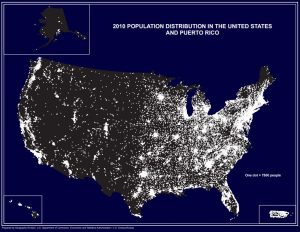Housing Now!
Elizabeth B. Pearce; Katherine Hemlock; and Carla Medel
Housing is another word for the place that families go each night to find shelter not only from the physical elements, but also to find enough emotional safety that they can become centered, rejuvenated, and sleep securely. In the best scenarios it provides not only security, but a place for families to love and nurture the self and one another.

Cardi B, a famous rapper (born as Belcalis Almanzar), describes being able to move out of her abusive boyfriend’s home with money earned from her work stripping in a club. “There were two pit bulls in that house, and I had asthma. There were bed bugs, too,” she told Vibe. “On top of that, I felt like my ex-boyfriend was cheating on me, but it was like even if he was cheating on me, I still can’t leave because—where was I gonna go?”[1]
In Cardi B’s case, she had safety from the outside physical world. But she was not safe inside her home. This is just one example of the complexities of housing, and specifically the ways that inequities play out in the United States.
Income is the primary determining factor in housing access. Price, availability, location, and macroeconomics all play a role, but a family’s annual income is the main determinant in housing affordability.[2] Therefore, inequities in income distribution directly affect housing access, and the capability of families to be safe, secure, and able to function to their maximum potential.
Cardi B grew up living between two different Bronx neighborhoods in New York City. When she describes her parents, she says, “I have real good parents, they poor. They have regular, poor jobs and what not,” she said in an interview with Global Grind. “They real good people and what not, I was just raised in a bad society”[3]. It is common in the U.S. for families to have multiple wage-earners, with multiple jobs, and still be unable to afford adequate housing.

Part-time and temporary jobs frequently come with lower pay and fewer benefits such as health care, sick leave, and other paid and unpaid leaves. This makes it harder to budget for regular expenses such as food and housing. These jobs are unequally distributed by sex, immigration status, and ethnic groups. Affordable housing is defined as housing that can be accessed and maintained while paying for and meeting other basic needs such as food, transportation, access to work and school, clothing, and health care. Diverse income levels, reinforced by governmental and lending practices that discriminate based on racial-ethnic groups, immigration status, and socioeconomic status, widen the gap between those who are housing secure, housing insecure, and homeless.
Houselessness
In 2019, over a half million Americans were considered houseless. Many of these are children and youth. In early 2018, just over 180,000 people in 56,000 families with children experienced houselessness. More than 36,000 young people (under the age of 25) were unaccompanied youth who were houseless on their own; most of those (89%) were between the ages of 18 and 24 years.[4]
These recent statistics were collected for Oregon (2019):
- Total Houseless Population: 15,876
- Total Family Households Experiencing Houselessness: 1,147
- Veterans Experiencing Houselessness: 1,438
- Persons Experiencing Chronic Houselessness: 4,902
- Unaccompanied Young Adults (Aged 18-24) Experiencing Houselessness: 1,590
- Total Number of Houseless Students: 23,141
- Total Number of Unaccompanied Houseless Students: 3,575
- Nighttime Residence, Unsheltered: 2,511
- Nighttime Residence: Shelters: 1,855[5]

A recent national survey that included Linn-Benton Community College (LBCC) in Albany, Oregon found that students at the two-year institution had higher levels of houselessness than do their counterparts nationally. With a response rate of 9.7%, 558 of 5,700 surveyed LBCC students participated in the 2019 #RealCollege Survey Report instituted by Temple University in 2019. 19% of LBCC students reported experiencing houselessness in the past year, compared with 17% nationally. In addition, 53% of LBCC students reported experiencing housing insecurity (described below) in the past year, compared with 50% nationally.
This report indicates that more than half of community college students are struggling with some kind of stress related to having a safe, stable place to care for themselves and their families. Demographic factors that indicate a higher rate of houselessness and housing insecurity include being female, transgender, Native American, Black, Latinx, and 21 or older. Although men, Whites, young students (18-20) and athletes were less likely to experience houselessness or housing insecurity, they still did so in double-digit percentages.[6]

Living in tents, couch surfing and car sleeping all are forms of houselessness. In an effort to provide stability and safety to the houseless population, formal encampments called Tent Cities have popped up across America in response to the cost of living and other societal problems. Dignity Village in Portland Oregon provides a community that is self-organized and offers a bit of security. Because the majority of Tent Cities are not officially legal, people living in them lack stability and live under the threat of being swept or evicted. In 2017, there were 255 tent cities reported across the US, ranging in size from 10 to over 100 people living in them. “Of those [tent cities] where legality was reported, 75 percent were illegal, 20 percent silently sanctioned, and 4 percent legal.” Tent cities are a response to the fact that most city-run shelter beds are maxed out and affordable housing has not become available in response to the growing need.[7]
Houseless shelters provide needed temporary immediate service to over 1.5 million Americans each year.[8] Primarily federally funded, many nonprofit organizations also provide support and temporary shelter for families and individuals. Some are so full that they sleep people in shifts, especially in the cold of winter. Many houseless people have nowhere to go during the day; however, day shelters such as Rose Haven in Portland, Oregon, offer dignity and services to those in need. The shelter serves about 3,500 individuals, including women, children, and gender non-conforming people who experience trauma, poverty, and health challenges.
Tensions exist amongst tent dwellers, staff, and users of shelters, and the business and home-owning communities. This is exemplified in Corvallis, Oregon, where the community has struggled for years to find a permanent location for the men’s overnight cold-weather shelter. Advocates for people who are houseless argue for a location close to needed city services; accessibility is important when walking, bicycling, and public transportation are the primary modes of getting around. These needs bump up against business owners’ desires for welcoming environments. Most recently, churches outside of the downtown area have allowed people to erect tents on the church property.[9] With the outbreak of the COVID-19 pandemic, more people who are houseless are moving into tents, and the city has intentionally stopped removing illegal campsites. In addition, Corvallis is providing hygiene centers that include showers, hand-washing, laundry, and food services.[10]
The socially constructed ideas of “normal” or “acceptable” identities are barriers to many people in accessing shelter, housing and other services. In houseless shelters, transgender women may be refused admittance by the women’s shelter and at risk of violence at the men’s shelter. More progress must be made to provide security for all, regardless of identity.[11]
Another barrier some women with children face in seeking shelter from domestic violence is the shelter rules themselves. Early curfews and overly strict rules can compromise the empowerment of residents. Many women fleeing domestic violence find themselves facing punitive and inflexible environments that mimic the patterns of control they are trying to escape. The Washington State coalition against domestic violence, called Building Dignity, “explores design strategies for domestic violence emergency housing. Thoughtful design dignifies survivors by meeting their needs for self-determination, security and connection. The idea here is to reflect a commitment to creating welcoming accessible environments that help to empower survivors and their children.”[12]
Housing Insecurity
Housing insecurity is less transparent than houselessness. People who are houseless are somewhat visible, but we may be less likely to know whether or not someone is housing insecure. That’s because it is an umbrella term that encompasses many characteristics and conditions. Signs of housing insecurity include missing a rent or utility payment, having a place to live but not having certainty about meeting basic needs, experiencing formal or informal evictions, foreclosures, couch surfing, and frequent moves.[13] It can also include being exposed to health and safety risks such as mold, vermin, and lead, overcrowding, and personal safety fears such as abuse.[14] Cardi B’s living situation, which she describes as “practically homeless,” illustrates housing insecurity.
Housing insecurity can be defined as a social problem; the current estimates are that 10-15% of all Americans are housing insecure. The increase in the number of cost-burdened households, households that pay 30% or more of monthly income toward housing, is dramatic amongst families who rent homes. Since 2008, these households increased by 3.6 billion to include 21.3 billion by 2014. And households with the most severe cost burden (paying 50% or more for housing) increased to a record 11.4 million.[15] By definition, a cost-burdened household is one that also faces housing instability and insecurity.
Somewhere In-Between
A well-established housing system that is often left out of the ‘standard’ talks regarding housing is immigrant housing. There are many immigrants who come to the United States as part of a guestworker program, which dates back to 1942 with the Bracero Program and continues through the hiring today of H2-A workers. Although these folks are called “guest workers,” they are not treated in the way that we imagine treating honored guests when it comes to living spaces.
The protections provided to these guest workers vary depending on the program they are under, so the quality of living varies widely but is often low quality. The housing vicinities lack basic necessities and are often in areas considered to be dangerous. Many guest workers find themselves living in one-room containers that later may be split up between many workers. Other guest workers find themselves living in what are called ‘Tent Cities,’ placed right next to the field where they are picking crops. One tent is provided to fit multiple guest workers or an entire family.
These living spaces are often in very rural locations, which isolate these workers and make them totally reliant on their employers. Many employers forbid them from bringing visitors, which reinforces the guest workers’ dependence on the employer and limits the likelihood of reports about the poor living conditions or other violations.[16]
The Influence of Institutions: Governments and Lending Institutions
Federal, state, and local governments all influence housing access via laws, zoning rules, permitting processes, and regulations. In addition, the government has the power to regulate the way that most Americans access home ownership, which is a loan agreement between an individual or couple and a lending institution such as a bank or credit union. In fact, it is the lending institution who owns any home, until the individual or couple completely pays the mortgage, which is a combination of the home’s original price and the interest that is charged, typically over a 15-, 20-, or 30-year loan.

Together, government and lending institutions control who can borrow money, where they can access housing, the down payment required, and the interest rate that each family pays. These regulations do not treat all families equally: socioeconomic status, racial-ethnic identity, marriage and sexuality, and immigrant and documentation status have all played a role in lending policies over time in the United States. Immigrants and individuals with Deferred Action for Childhood Arrivals (DACA) status have difficulty securing loans due to ambiguous federal legislation affecting their status. People who do not have a social security number are eligible for loans, but these typically require a higher down payment and higher interest rates.
Home foreclosures added to the economic disparity following the housing market crash of 2008. Over half of US States were affected by prior predatory lending practices and lack of oversight of the banking system. Uninsured, private market subprime loans were made available with looser requirements, quickly driving up the price of homes so that some people owed more on their house than it was worth. Many were considered “underwater in their loans” or “upside-down” in their home value and defaulted on payments. Banks took back homes and many families were forced into shelters, into living in their cars, or into the homes of family members increasing the numbers of cost-burdened, housing insecure, and houseless families.
Where Families Live
Considering the location of families in the United States, we will briefly look at three factors: geography; household size; and types of locations, which commonly include urban, suburban, and rural communities. Exurbs, a relatively new term, describes areas just outside of suburban communities which typically feature low density housing and large homes. These may overlap into farm or forested areas, but are not considered rural.
Geography

Population distribution is divided into four main regions by the U.S. Census Bureau in order to register the population: the Northeast, Midwest, South, and West; see the map below for divisions within regions.
Population is spread unevenly across the United States with density focused in the Northeast and Southern regions, and two smaller divisions: the East North Central in the Midwest, and the Pacific division of the West, which includes Oregon.

Although the population of the United States is growing, the rate of growth is slowing as exemplified by the most populous states listed in descending order: California, Texas, Florida, and New York and for the states that are increasing in population. The four states that have the largest numeric growth in the past ten years are Texas, Florida, Arizona and North Carolina. The states with the most growth, percentage wise, are Idaho, Nevada, Arizona, and Utah, experiencing between 1.7% and 2.1% growth in the past year (2018-2019).[17] For comparison, Oregon grew 1.3% in the same time period.[18]
Communities
Where families live can also be examined related to living in urban, suburban, rural, and exurban areas. Over the second half of the 20th century and the first part of the 21st century, families generally moved away from urban centers and into the suburbs. But the recession of 2008-2015 reversed that trend and urban areas made some growth, while suburbs and exurbs declined. Since 2016, the overall trend has again shifted, increasing family growth in suburbs and metropolitan areas (as opposed to urban cores), with Midwestern metro areas seeing the most growth.[19] To understand the demographics of who lives in which kind of community, read this article from the Pew Research Center: What Unites and Divides Urban, Suburban and Rural Communities. Values, racial-ethnic groups, and education are all factors in family location.
Environments and locations have differing health advantages and risks. Air quality, access to green spaces, clean water, and places to recreate are often described as “quality of life” factors. But a greater emphasis is critical as these are considered to be as important to overall health as are genetics and lifestyle.[20] Air and water will be discussed more in depth in the Food, Water, and Air chapter of this text. With the advent of shelter-at-home restrictions related to the pandemic of COVID-19, home environments have become even greater a factor in our overall health. For more on how to assess your environment and its importance to health, watch this TEDMED TALK with Bill Davenhall.
Household Size
Household size had been declining from 1790 through 2010, going from an average size of 5.79 people to 2.58 people. Since then it has increased to 2.63 people in 2018. This increase is likely due to several factors. The recession affected families across the United States and many families “doubled up” in their housing. In addition, the trend of young adults living with their parents for longer periods of time decreases the number of independent households.[21] And there is an increase in multigenerational households. This reflects the growing racial-ethnic diversity in the United States; Asian, Hispanic, and Black families are more likely to live in multigenerational households than are non-Hispanic Whites.[22] The trend of increasing household size is important to note because it will likely impact the economy in the United States if it continues, as it will influence that amount of new housing construction.
Licenses and Attributions
Open Content, Shared Previously
Figure 9.1. “Cardi B live auf dem Openair Frauenfeld 2019″ by License: CC BY-SA 4.0.
Figure 9.2. “home sweet home” by Libor Gabrhel. License: CC BY-NC-ND 2.0.
Figure 9.4. “Whoville Homeless Camp (Eugene, Oregon)” by Visitor7. License: CC BY-SA 3.0.
Figure 9.5. Photo by Pxfuel. License: Pxfuel terms of use.
Figure 9.6. “Census Regions and Division of the United States” by US Census Bureau. Public domain.
Figure 9.7. “2010 Population Distribution in the United States and Puerto Rico” by US Census Bureau. Public domain.
All Rights Reserved Content
Figure 9.3. “Comparison of Basic Needs Insecurity Rates” (c) The Hope Center. Used with permission.
- Akhtar, A. (2017, September 27). How Cardi B escaped poverty to become the first female rapper in 19 years to top the charts. http://money.com/how-cardi-b-escaped-poverty-to-become-the-first-female-rapper-in-19-years-to-top-the-charts/ ↵
- Tilly, C. (2006). The economic environment of housing: Income inequality and insecurity. In R. G. Bratt, M. E. Stone, and C. Hartman, A right to housing: Foundation for a new social agenda (pp. 20-35). Temple University Press. ↵
- Shamsian, J. & Singh, O. (2019, October 10). How Cardi B went from a stripper to a chart-topping rapper. Business Insider. https://www.insider.com/who-is-cardi-b-bodak-yellow-2017-9 ↵
- U.S. Department of Housing and Urban Development. (2018, December). The 2018 annual homeless assessment report to Congress. https://files.hudexchange.info/resources/documents/2018-AHAR-Part-1.pdf ↵
- United States Interagency Council on Homelessness. (2019, January). Oregon homelessness statistics. https://www.usich.gov/homelessness-statistics/or/ ↵
- Goldrick-Rab, S., Baker-Smith, C., Coca, V., Looker, E. & Williams, T. (2019, April). College and university basic needs Insecurity: A national #RealCollege survey report. The Hope Center. https://hope4college.com/wp-content/uploads/2019/04/HOPE_realcollege_National_report_digital.pdf ↵
- Invisible People. (n.d.). How many people live in tent encampments? https://invisiblepeople.tv/tent-cities-in-america/ ↵
- Popov, I. (2017, February). Shelter funding for houseless individuals and families brings tradeoff. Center for Poverty Research, University of California , Davis. https://poverty.ucdavis.edu/policy-brief/shelter-funding-homeless-individuals-and-families-brings-tradeoffs ↵
- Hall, B. (2019, April 10). Corvallis, Benton County homeless council reboot moves ahead. Albany Democrat Herald. https://democratherald.com/news/local/corvallis-benton-county-homeless-council-reboot-moves-ahead/article_d2f33b88-a911-5d29-ba27-77bc499a1dfc.html ↵
- Day, J. (2020, May 4). Corvallis to aid shelter hygiene center. Albany Democrat Herald. https://democratherald.com/news/local/corvallis-to-aid-shelter-hygiene-center/article_d1562ff0-6e81-5914-bfc1-91d9a6d6b89c.html ↵
- National Center for Transgender Equality. (2019, June 9). The Equality Act: What transgender people need to know. https://transequality.org/blog/the-equality-act-what-transgender-people-need-to-know ↵
- Washington State Coalition Against Domestic Violence. (n.d.). Building dignity: Design strategies for domestic violence shelter. https://buildingdignity.wscadv.org/ ↵
- Office of Policy Development and Research. US Department of Housing and Urban Development. (n.d.). Measuring housing insecurity in the American housing survey. PD&R Edge Magazine. https://www.huduser.gov/portal/pdredge/pdr-edge-frm-asst-sec-111918.html ↵
- Health People 2020. Office of Disease Prevention and Health Promotion. (n.d.). Housing instability. https://www.healthypeople.gov/2020/topics-objectives/topic/social-determinants-health/interventions-resources/housing-instability ↵
- Joint Center for Housing Studies. Harvard University. (2016, June 22). The state of the nation's housing 2016. https://www.jchs.harvard.edu/research-areas/reports/state-nations-housing-2016 ↵
- Southern Poverty Law Center. (n.d.). Guest worker rights. Retrieved February 20, 2020, from https://www.splcenter.org/issues/immigrant-justice/guest-workers ↵
- United States Census Bureau. (2019, December 30). 2019 US population estimates continue to show the nation's growth is slowing. https://www.census.gov/newsroom/press-releases/2019/popest-nation.html ↵
- Portland State University. (2019, November 15). PSU's Population Research Center releases preliminary Oregon population estimates. https://www.pdx.edu/news/psu%E2%80%99s-population-research-center-releases-preliminary-oregon-population-estimates ↵
- Frey, W. H. (2018, March 26). US population disperses to suburbs, exurbs, rural areas, and “middle of the country” metroes. The Brookings Institution. https://www.brookings.edu/blog/the-avenue/2018/03/26/us-population-disperses-to-suburbs-exurbs-rural-areas-and-middle-of-the-country-metros/ ↵
- Office of the Surgeon General. U.S. Department of Health and Human Services. (2019, May 14). Healthy homes reports and publications. Retrieved May 14, 2020, from https://www.hhs.gov/surgeongeneral/reports-and-publications/healthy-homes/index.html ↵
- Fry, R. (2019, October 1). The number of people in the average U.S. household is going up for the first time in over 160 years. Pew Research Center. https://www.pewresearch.org/fact-tank/2019/10/01/the-number-of-people-in-the-average-u-s-household-is-going-up-for-the-first-time-in-over-160-years/ ↵
- Menasce Horowitz, J., Brown, A., & Cox, K. (2019, April 9). Views on race in America 2019. Pew Research Center. https://www.pewsocialtrends.org/2019/04/09/race-in-america-2019/ ↵
Lack of fair treatment, opportunity, or conditions.
Housing that can be accessed and maintained while paying for and meeting other basic needs such as food, transportation, access to work and school, clothing, and health care
The combination of one’s social and economic status, specifically related to income, education, and career or job status.
Describes a lack of access to stable housing, which may include individuals who must move frequently, cannot afford rent, live with relatives, are overcrowded, or who do not have adequate housing quality.
Being in the state of not having access to stable housing. Couch surfing, tent cities, shelters, and living in a car are all examples of houselessness.
An identity that describes a person who holds a gender identity that is different from the one they were assigned at birth.
Meaning assigned to an object or event by mutual agreement (explicit or implicit) of the members of a society; can change over time and/or location.
A large issue that affects many people, can threaten the health and well being of society, is recognized as a problem by many, includes multiple causes and effects, and needs a systemic solution.
When 30% or more of a household’s monthly gross income is dedicated to housing, making it difficult to pay for necessities (food, clothing, medical care).
A 1942 agreement between the United States and Mexico that guaranteed adequate living conditions, a 30-cent per hour minimum wage, and other benefits for migrant farmworkers.
A temporary agricultural visa which allows foreign nationals to enter into the U.S. to perform agricultural labor or services of a temporary or seasonal nature.
A United States immigration policy that allows individuals who arrived in the United States as children to remain and work in the country for a renewable period of two years. This policy has been legalized and implemented inconsistently in the 2000s.
Areas just outside of suburban communities which typically feature low density housing and large homes. These may overlap into farm or forested areas, but are not considered rural.

